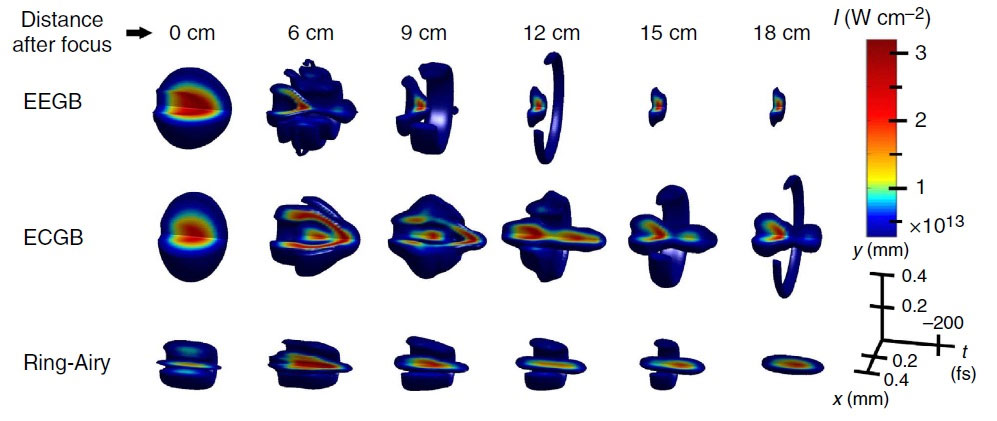
نام اژدرهای نوری احتمالا شما را به یاد سری فیلمهای جنگ ستارگان و اسلحههای نوری میاندازد ولی این موضوع کم کم دارد رنگ واقعیت به خود میگیرد. دانشمندان موفق شدند تا با کنترل انتشار پرتو نور با شدت بالا مفهوم گلولههای نوری را به واقعیت تبدیل کنند. این پرتو نور که Ring-Airy خوانده میشود، با خاصیت متمرکز شوندگی که دارد، شدت گرفته و قادر است مسافتهای طولانی را بپیماید.
این پاکتهای موجی با شدت بالا میتوانند در زمینههای مختلفی از جمله لیزرها مورد استفاده قرار بگیرند. پرتوهای Airy از این خاصیت ویژه برخوردارند که میتوانند در طول انتشار در فضا به شکل قوسهای سهمی وار دربیایند. این پرتوهای Ring-Airy در رژیم خطی خود میتوانند خود را به صورت نقطهای متمرکز کنند و همین مورد آنها را برای کاربرد در لیزرها فوق العاده مناسب میکند. در مطالعات جدید، دانشمندان رژیم غیر خطی این پرتوها را مورد بررسی قرار دادند و متوجه شدند که در این حالت ویژگیهای بسیار عجیب تر و البته مفید تری را میتوان از این پرتوها انتظار داشت.

این پرتوها در این شرایط به شکل گلولههای نوری با شدت بالا گسترش مییابند که آنها را قادر میسازد تا فاصلههایی بسیار بیش از لیزر معمولی با استفاده از پرتوهای گاوسی را بپیماید. پژوهشگران همچنین دریافتند که با افزایش قدرت منبع اولیه این پرتوها برخلاف پرتوهای گاوسی دچار تغییر در نقطهی کانونی نمیشوند.
پرتوهای ring-Airy با شدت و تمرکز بالایی که دارند، قابلیت کنترلی را به ما میدهند که تا پیش از این با استفاده از پرتوهای گاوسی دستیابی به آن ناممکن بود که این مورد کاربردهای خارق العاده و جدید آنها را نوید میدهد.
منبع : vr-zone
Scientists make bullets from light
By using a special light beam known as a ring-Airy beam, scientists have managed to concentrate light rings into a “bullet” which provides more control and precision than a conventional laser is capable of.
Photon torpedo is a term most people recognize from Star Trek, but the idea of a projectile made from light isn’t science fiction at all. The newly discovered ring-Airy beam is a type of light beam that concentrates into an intense light bullet that can propagate over large distances. The discovery could mean big things for several industries, including laser micromachining and harmonic generation. P. Panagiotopoulos, D.G. Papazoglou, A. Couairon and S. Tzortzakis, four french and greek scientists have collaborated on the technology and recently published their findings in Nature Communications.
The Airy beam has the distinct feature of bending into an arc as it moves through space and gets it’s name from the Airy integral, developed by Sir George Biddell Airy to describe how light bends in a rainbow. Back in 2011, the Airy-beam was first tested and made into the shape of a ring. Over a distance, such a ring can be concentrated linearly into a single point of light, perfect for industrial applications in hard to reach places. However, the researchers have now compressed the ring-Airy beam non-linearly, and found that by doing so, the ring doesn’t spread over distance or time, and in fact, retains its intensity better than the Gaussian beams used in conventional lasers. In addition, when the intensity of the beam is increased, it remains on target better than conventional laser do as well. Long story short: they’re better.
 گجت نیوز آخرین اخبار تکنولوژی، علم و خودرو
گجت نیوز آخرین اخبار تکنولوژی، علم و خودرو 





